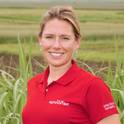
A key goal of precision agriculture is to achieve the maximum crop yield while minimizing inputs and loses from cropping systems. The challenge for precision agriculture is that these factors interact with one another on a subfield scale. Seeding density and nitrogen (N) fertilizer application rates are two of the most important inputs influencing agronomic, economic and environmental outcomes in cropping systems including yield, return on investment (ROI), and nitrate (NO3−) leaching. Here a cropping system model framework is used to predict site-specific subfield optimum seeding density and (N) fertilizer application rates based on publicly available data sources. The framework is used estimate differences in yield, ROI, NO3− leaching, and N2O emissions corresponding with economic optimum (maximum ROI) and agronomic optimum (maximum yield) inputs. The framework couples the process-based APSIM cropping system model with the SSURGO soils database, Daymet weather data service, land grant university estimates of crop production costs and commodity price estimates, and the R statistics software. Framework performance was evaluated using multiple years of precision yield monitor data obtained from a conventionally managed continuous maize (Zea mays L.) cropping system field located in north central Iowa on which varying N-fertilizer rates were applied. Subfield model estimates of crop yield were sensitive to initial conditions related to historical management of the field and had an r2 = 0.65 and a root mean square error of 1645.0 kg ha−1. A site-specific application of the framework comparing economic optimum seeding density and N-fertilizer rates with agronomic optimum values estimated an average ROI benefit of 7.2% as well as an average NO3− leaching and N2O emissions reductions of 2.5 and 7.6 kg ha−1, respectively. However, in a minority of cases NO3− leaching was greater at the economic optimum, indicating that managing to maximize ROI rather than yield may not always reduce environmental impacts. Our results suggest that managing cropping systems for the economic optimum is plausible using publicly available data with our framework and will likely lead to improved environmental outcomes.
Available at: http://works.bepress.com/emily-heaton/62/

This article is published as McNunn G, Heaton E, Archontoulis S, Licht M and VanLoocke A (2019) Using a Crop Modeling Framework for Precision Cost-Benefit Analysis of Variable Seeding and Nitrogen Application Rates. Front. Sustain. Food Syst. 3:108. doi: 10.3389/fsufs.2019.00108.